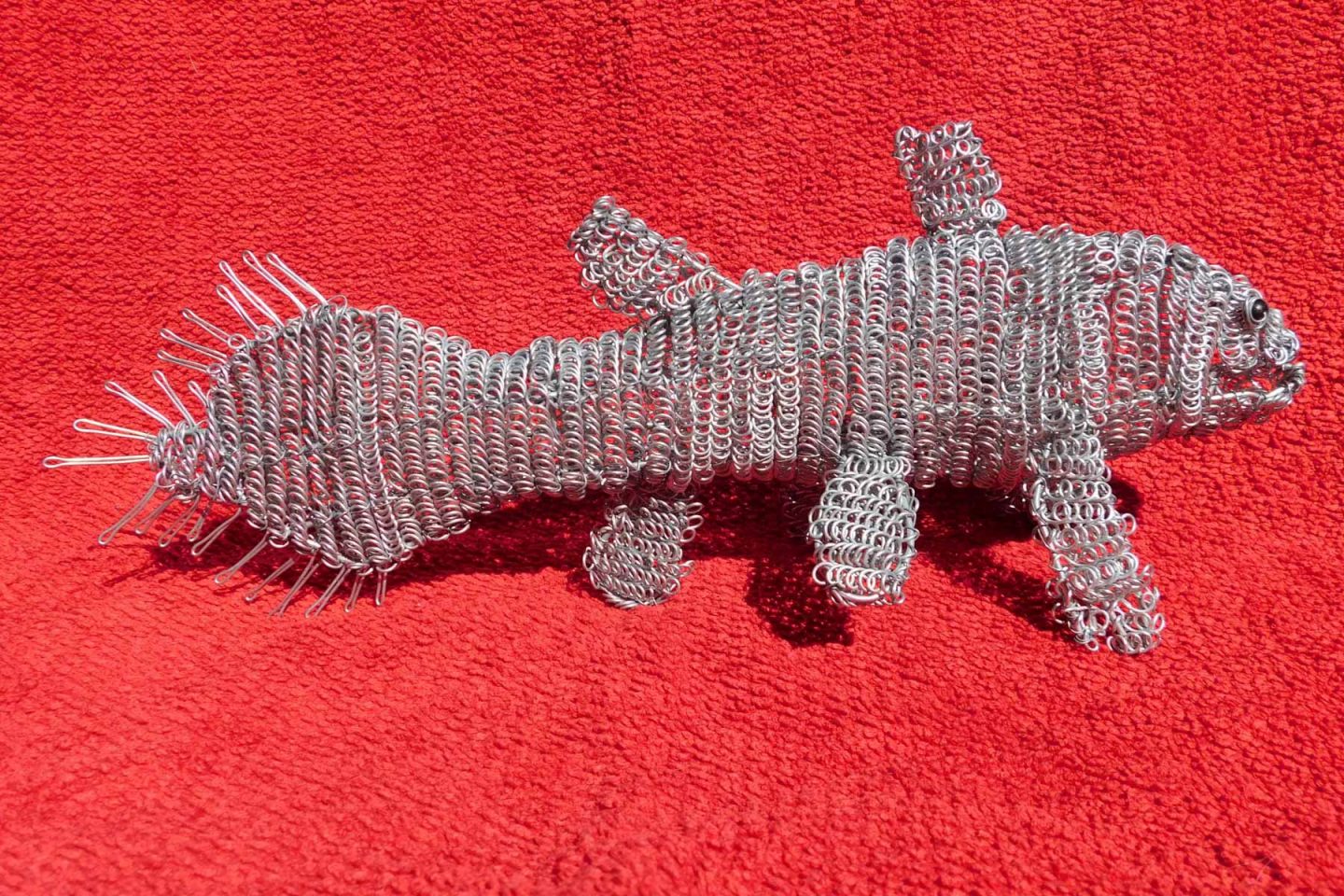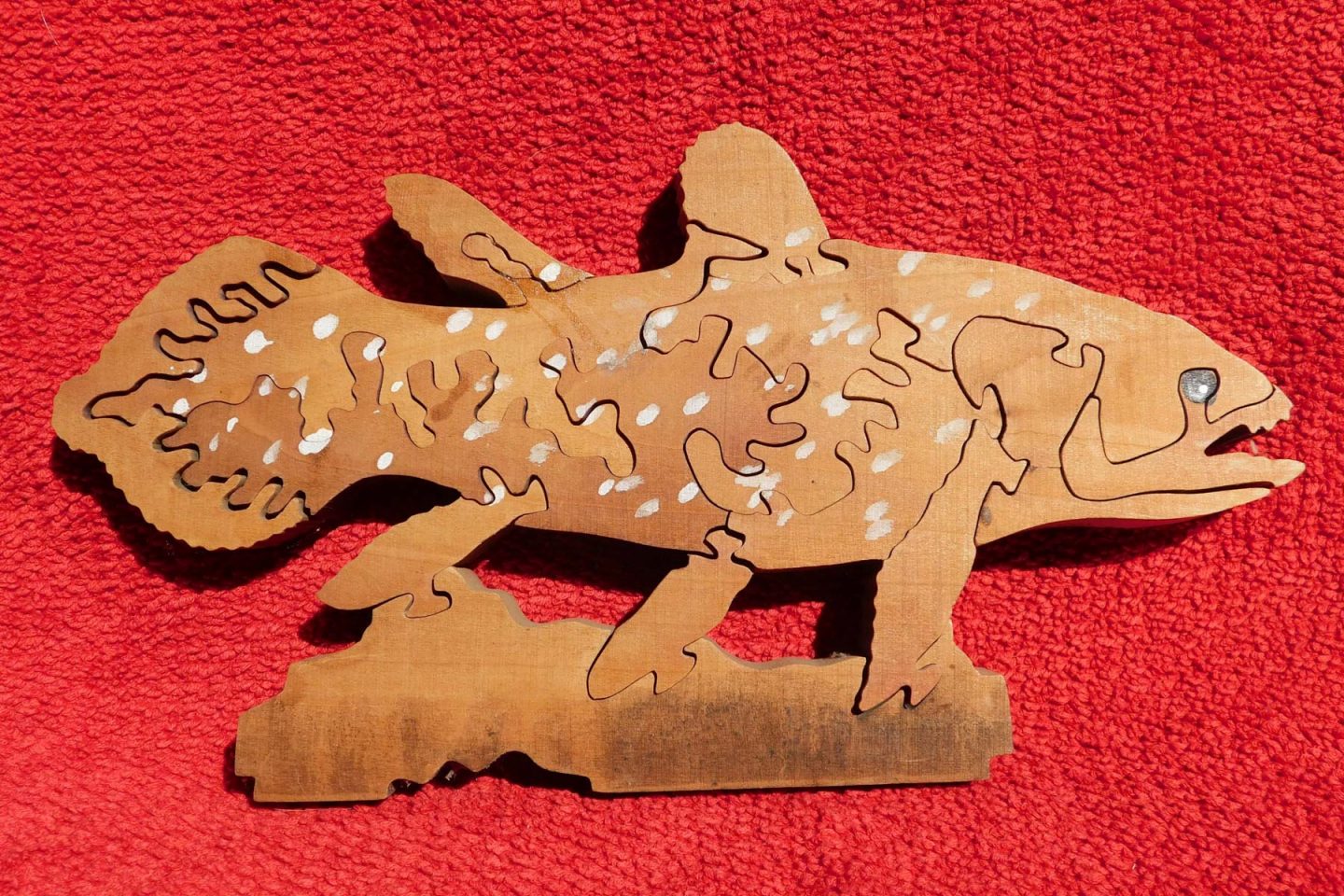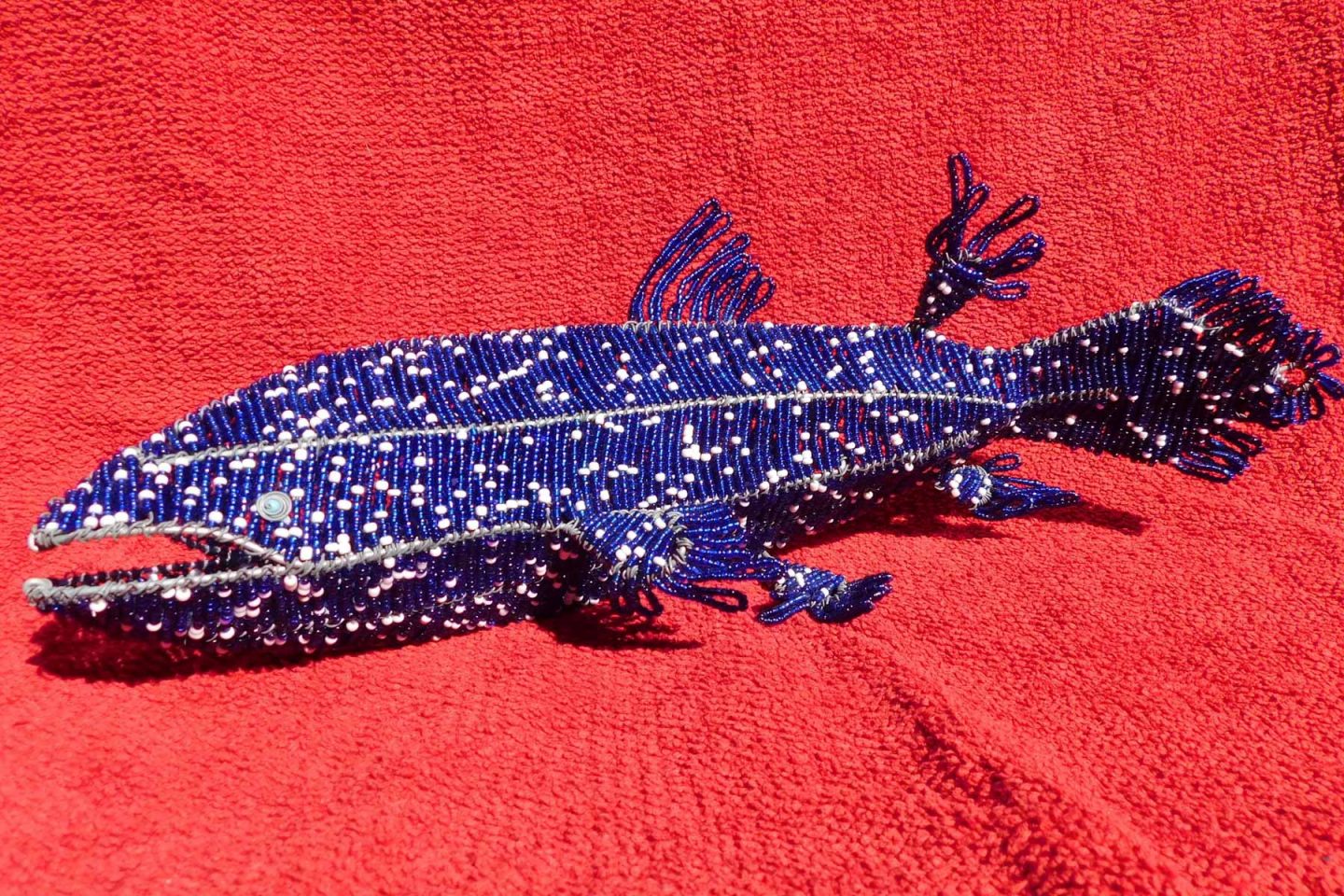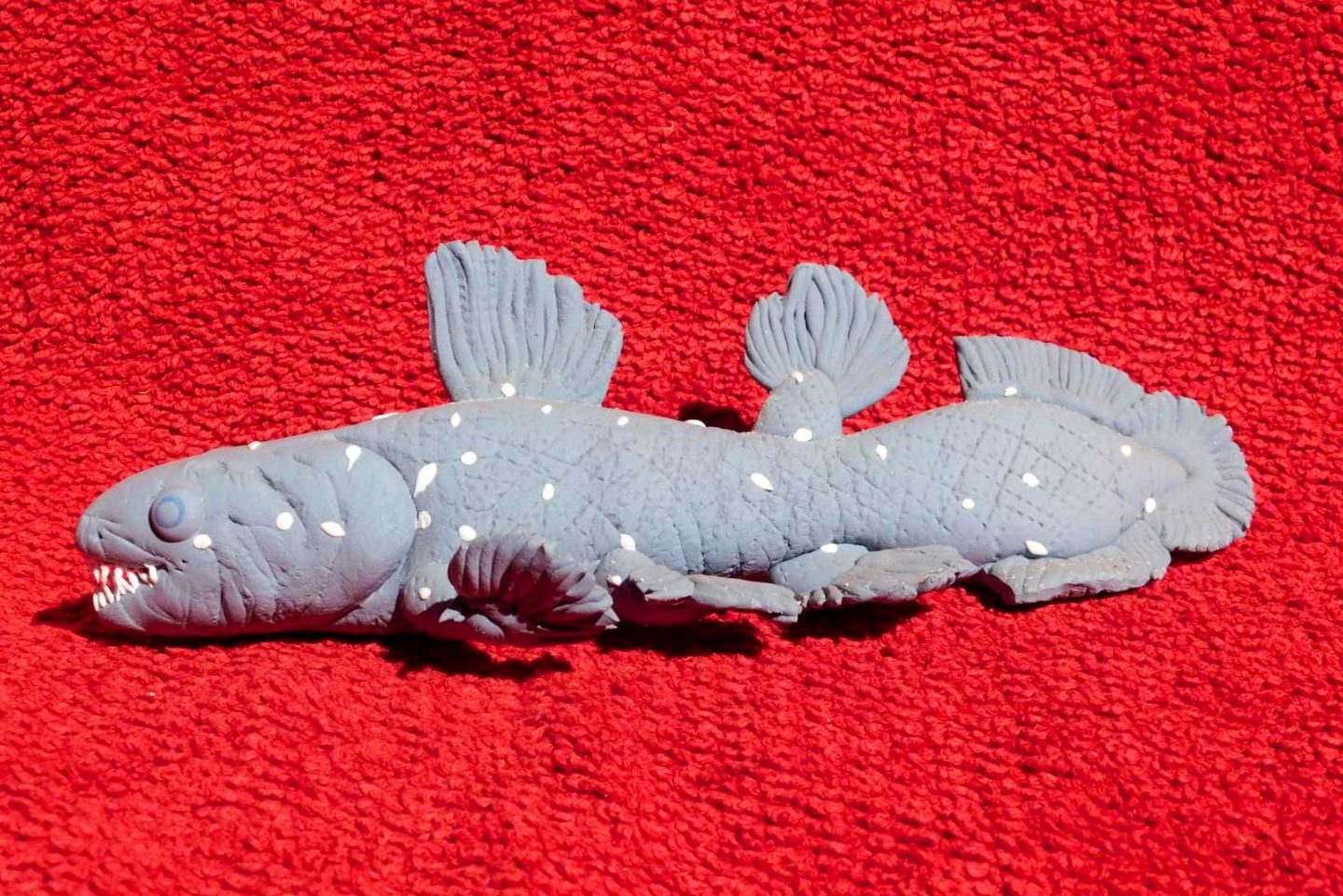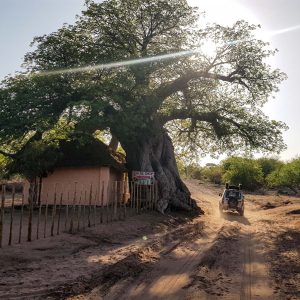Celebrating the world’s most famous fish through art
South Africa’s ‘fossil fish’ has fascinated scientist Mike Bruton since boyhood. Now 73, he is commissioning craftspeople to carve, shape and sculpt the coelacanth.
Author:
7 May 2020

Some people collect old postage stamps. Others spend years hunting down books, bird eggs, coins or Dinky Toys. You name it, and someone probably has a collection of them somewhere.
All the same, South African fish scientist Mike Bruton can surely boast one of the world’s most unique art collections. For several decades he has been collecting fish pieces. Not just any old fish, but a unique trove of art and artefacts that revolve around coelacanths.
The coelacanth (pronounced see-la-kanth) is one of the world’s most ancient fish species, which “returned from the dead” just over 80 years ago.
The fish gets its name “hollow spine” from the Greek words koilos (hollow) and akantha (spine).

In Bruton’s view, coelacanths have become one of the most famous animals in the world – with a status comparable to panda bears – following the remarkable discovery of a lone specimen off the coast of East London just before Christmas in 1938.
Its appearance captured the imagination of the world when it became known that this large, metallic blue fish with white spots was a “living fossil”, a 400 million-year-old creature that predates dinosaurs and yet is still alive.
With four lobed fins resembling limbs, the creature was soon named “Old Four Legs” amid scientific conjecture that it was a missing evolutionary link, a relative of one of the first creatures to crawl from the deep sea to become a four-legged land animal.
Literature and politics
Bruton has since discovered several references to this ancient marine fish creeping into literature and political debate. Former British prime minister Winston Churchill, for example, once spoke about “that coelacanth of a man” in reference to a backbencher who remained mostly silent for nearly 20 years in the British House of Lords and then got up to make a great speech.

In 2003, historian Peter Catterall characterised another former United Kingdom prime minister, Harold Macmillan, as “the coelacanth of modern British politics”. And UK Prime Minister Boris Johnson used the term in a much more pejorative sense in November last year when he described former Labour Party leader Jeremy Corbyn as a political coelacanth and fossil “dredged up in the nets of some super-trawler from the Marianas Trench of politics”.
Among the items that make up Bruton’s collection are several coelacanth T-shirts, including one that mocks the pedigree of Land Rovers by recognising the coelacanth as “The Oldest Four by Four by Far”.
In fact, says Bruton, coelacanths do not use their four limb-like fins to walk as they spend most of their time hovering silently in deep underwater canyons. And though the term Old Four Legs was a catchy narrative, it proved to be scientifically inaccurate as subsequent research now suggests that lungfish are the closest living marine relatives to four-legged land mammals.
Coelacanth stories
Each of the objects Bruton has collected tells a story. He has an unopened packet of 20 Le Coelacanth filter cigarettes that he bought many years ago on the Comoros islands, north of Madagascar. The cigarettes were marketed to celebrate the discovery of one of the largest remaining colonies of these critically endangered fish.

Bruton’s fascination with coelacanths and the ocean stretches back to his boyhood in East London, where he saw a preserved specimen of the famous fish in the city’s museum. At the age of 10, he also met Marjorie Courtenay-Latimer, who found that first specimen and helped inspire his love for ecology. (One of the most valuable items in his collection is the original sketch she made of this first specimen.)
Writing in his autobiographical memoir, When I Was a Fish: Tales of an Ichthyologist, Bruton recalls that he developed a love for the sea at an early age. “I built a tree house in our avocado pear tree and from this ‘crow’s nest’ I could see the sea. I would dress up as a pirate and survey the ships sailing in and out of the harbour through my homemade telescope.”
He also spent hours collecting insects or exploring the rock pools in the intertidal zone. After school, he studied zoology and ichthyology at the university currently known as Rhodes University.
As an undergraduate, he met the “Fishy Smiths”, JLB Smith and his wife Margaret Smith, the scientists who named the first specimen as Latimeria chalumnae and who also found a living coelacanth in the Comoros in 1952. It was only the second specimen positively identified in modern history at that time.
He remembers JLB as an extremely strict and rather taciturn man. “If you said 30 words to him, he would generally respond with just a single word, normally while dissecting a fish and without even looking up at you.”
Nevertheless, Bruton was deeply inspired by the Smiths’ scientific curiosity and fascination for coelacanths and other marine fish, and he went on to become the founding head of the department of ichthyology and fisheries science at Rhodes, director of the JLB Smith Institute of Ichthyology and director of the Two Oceans Environmental Education Trust in Cape Town.
Fish tchotchkes
Gradually, during his research trips to East Africa, the Indian Ocean islands and further afield, Bruton began to collect objects such as beer and wine bottles, toys, art, literature and poetry associated with the coelacanth.
On the island of Zanzibar, he bought a Tinga Tinga-style painting from artist Suleiman Awaz. In the Comoros, he acquired a coelacanth craft basket from a street vendor.
There is also a glass coelacanth and a 1963 Wedgwood plate donated to him by the East London Museum, a playdough coelacanth made by students at the Bahrain Science Centre in 2014 and a painting by Brenda Quirk entitled Feline Fantasy, featuring a cat eyeing one of the famous fish.
Following decades of personal research, Bruton has given several talks around the world about the coelacanth story and often takes at least part of his collection along to help illustrate his presentations.
Art, science and conservation
Now 73, Bruton continues to raise awareness about the fish he fell in love with as a boy. Over the past few years, he has commissioned several craftsmen and craftswomen from southern and eastern Africa who sell their work in the informal sector to produce coelacanth models using the wide variety of materials they traditionally use for making curios.
“I give the artists a photograph of the coelacanth and ask them to make models about 25cm to 30cm long. The models are not intended to be scientifically accurate, but rather to take on the general shape of the fish and to reflect the individual talent and interpretation of the artist.”
So far, some of the more recent models have been fashioned from coiled wire, wire and tin, rusted metal, carved wood, fabric, painted wood, and wire and beads. He was particularly pleased with a model produced earlier this year by Cape Town artist Davis Ndungu, made from brightly coloured fragments of rubber slip-slops.

Other favourites include a coiled wire coelacanth by Zimbabwean artist Sheldon Marimo, and a metal and fabric fish produced by craftswomen from the Keiskamma area in the Eastern Cape, which he bought at the National Arts Festival in Makhanda in 2013. He hopes to commission other craftspeople to produce models from baked clay, sticks, soapstone, candle wax and banana leaves.
“This project has not only supported the work of traditional craftsmen and women but has resulted in a fascinating collection of items that reflect the different ways in which the iconic shape of the coelacanth can be interpreted, a wonderful crossover between art and science.
“I pay the crafters well for their work and, in some cases, I will probably be able to set up some supply lines for them to make and sell their crafts to museums.”
Bruton hopes to exhibit the full collection at the centenary celebrations of the East London Museum next year. The underlying reason for his endeavour, he says, is to celebrate a global but also uniquely South African conservation story.
Related article:
For many years, the first coelacanth found near East London was presumed to be a stray animal that was pushed far southwards by strong currents. But in November 2000, local divers found and filmed several of these creatures sheltering in the deep-water canyons off Sodwana Bay, in the iSimangaliso Wetland Park on KwaZulu-Natal’s northern coast.
More recently, in November 2019, other local divers found another, lone coelacanth off the South Coast of KwaZulu-Natal, suggesting that the original specimen was not a stray but part of a resident population yet to be discovered off the coast of the neighbouring Eastern Cape province.
Preservation in the face of ‘progress’
Bruton remains extremely worried about the future of the species in an era when coastal fishing communities have access to increasingly destructive technologies such as gill nets and global corporations are scouring known breeding grounds for oil and gas.
The first fossil records for coelacanths stretch back 480 million years. They belong to a very small family of fish – less than 2% – that give birth to live young rather than release eggs.
“The gestation period for coelacanths is now thought to be 36 months, almost a year longer than elephants. Baby coelacanths are about 33cm long and weigh almost 500g at birth, and there are records of pregnant fish containing between 24 and 36 babies when they were caught by fishermen in Mozambique and Tanzania,” says Bruton.

“So, when a single pregnant coelacanth is caught with so many unborn babies, you have to be very concerned about all that lost breeding effort and about the future of this species. There are still so many things we just don’t know about them,” he adds, noting that they have all the characteristics of an animal that could go extinct in the blink of an eye.
“They are very precious. That’s why we have a responsibility to keep raising public awareness to ensure that they survive.”

